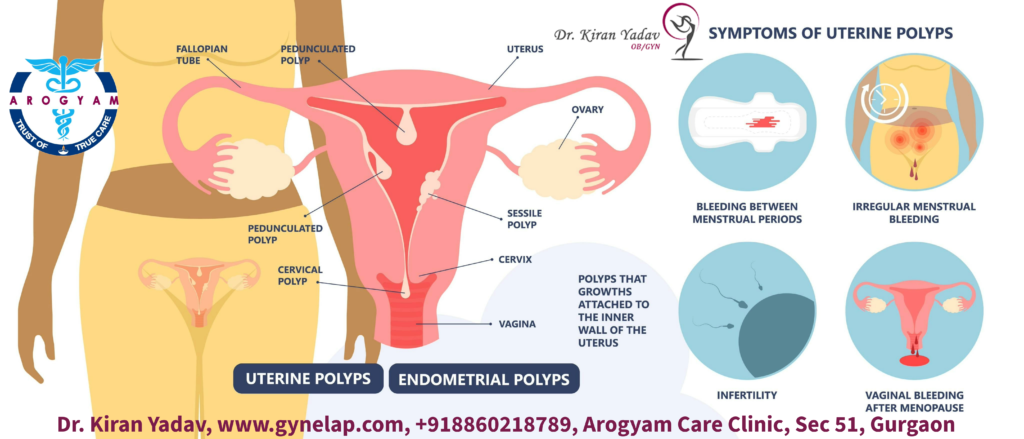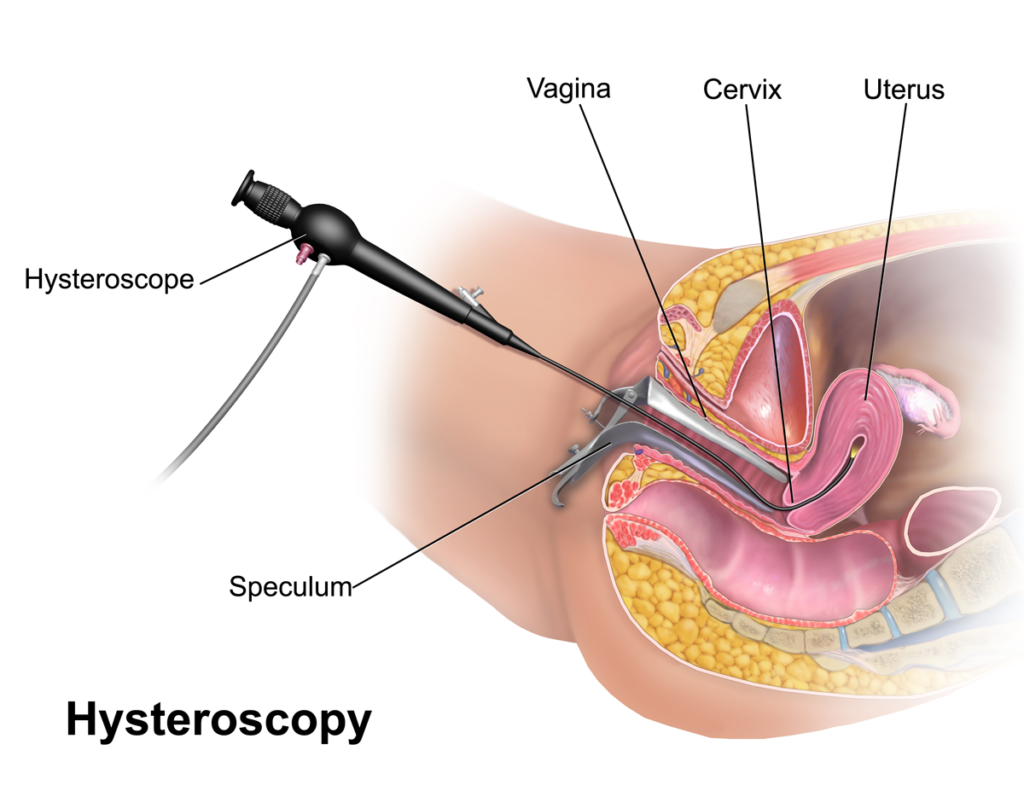What is Endometrial Polypectomy or Uterine Polypectomy?
Uterine Polypectomy are abnormal growths of cells that may cause irregular or heavy bleeding, infertility, or pelvic pain. Most polyps are benign (noncancerous), but some may be malignant (cancerous) or precancerous. Uterus polypectomy is a procedure to remove polyps from the inner lining of the uterus, also known as the endometrium.

Why Uterine Polypectomy is done? Symptoms of uterine polyps
Uterus polypectomy is done to:
- treat the symptoms caused by uterine polyps. Uterine polyp symptoms includes abnormal uterus bleeding, pain lower abdomen and sometimes infertility.
- to prevent them from becoming cancerous
- Polypectomy also improve the chances of pregnancy in people who have infertility due to polyps.
How is Hysteroscopic Polypectomy done?
Uterus polypectomy is usually done using a thin, flexible instrument called a hysteroscope, which is inserted through the vagina and cervix into the uterus. The hysteroscope has a light and a camera that allow the doctor to see the inside of the uterus on a monitor. The doctor can then use small tools attached to the hysteroscope to cut or burn off the polyps. The polyps are then removed through the hysteroscope or with suction.
Polypectomies are minimally invasive procedures, often performed using endoscopic techniques, which involve inserting a flexible tube with a camera into the body to locate and remove the polyp. The procedure is commonly performed during diagnostic tests such as colonoscopies or hysteroscopies.
1. Types of Polyps
Polyps can vary in shape, size, and location. The most common types include:
Adenomatous Polyps (Adenomas): These are considered pre-cancerous and have the potential to develop into colon cancer if not removed.
Hyperplastic Polyps: These are generally benign and have a low risk of turning cancerous.
Sessile Serrated Polyps: Found in the colon, these can increase the risk of colon cancer and may require removal.
Inflammatory Polyps: Commonly associated with inflammatory bowel diseases, such as Crohn’s disease or ulcerative colitis.
Endometrial Polyps: These polyps develop in the lining of the uterus and may cause irregular bleeding. They are typically benign but can sometimes lead to endometrial cancer.
2. When Is a Polypectomy Needed?
A polypectomy is recommended when polyps are found during routine screenings or diagnostic tests, such as:
Colonoscopies: Polyps in the colon or rectum can be detected and removed to prevent the development of colorectal cancer.
Hysteroscopies: Uterine polyps can be removed during a hysteroscopy to address symptoms like abnormal uterine bleeding or infertility.
Gastroscopies: Polyps in the stomach or esophagus may be removed to prevent potential complications like obstruction or malignancy.
Nasal Endoscopy: Nasal polyps causing congestion, breathing difficulties, or sinus infections can be removed.
3. The Polypectomy Procedure
The method of polypectomy depends on the size, location, and type of polyp. Most polyps are removed during a diagnostic endoscopy, which is a non-invasive or minimally invasive procedure.
A. Colon Polypectomy:
A colon polypectomy is often performed during a colonoscopy. The steps include:
Preparation: The patient undergoes bowel preparation before the procedure to clean the colon. This usually involves drinking a laxative solution the night before.
Sedation: The patient is sedated to ensure comfort during the procedure.
Procedure: A colonoscope (a long, flexible tube with a camera) is inserted through the rectum to examine the colon. If polyps are found, they can be removed using a snare, which loops around the base of the polyp and cuts it off. Sometimes, forceps or a heat tool (cautery) may be used.
Recovery: Most patients can return home the same day after a short recovery period. Full recovery may take a day or two.
B. Uterine Polypectomy:
Uterine polyps are removed via hysteroscopy. Here’s what to expect:
Preparation: The procedure is usually done under local or general anesthesia, depending on the size of the polyp and patient comfort.
Procedure: A hysteroscope (a thin, lighted tube) is inserted through the cervix into the uterus. The doctor visualizes the uterine cavity and uses small surgical tools to remove the polyp.
Recovery: Most women experience light bleeding and cramping afterward. Recovery is quick, with normal activities resuming in a few days.
4. Benefits of Polypectomy
A polypectomy is a safe and effective way to prevent future health complications. The benefits include:
Cancer Prevention: Removing polyps, especially adenomatous polyps, can significantly reduce the risk of developing cancers such as colorectal cancer and endometrial cancer.
Symptom Relief: In cases where polyps cause symptoms like abdominal pain, irregular bleeding, or nasal obstruction, removal can offer immediate relief.
Minimally Invasive: Polypectomies are typically performed using minimally invasive techniques, which mean less discomfort, shorter recovery times, and minimal scarring.
Diagnostic Clarity: In addition to preventing cancer, removing and analyzing polyps can help doctors diagnose conditions such as inflammatory bowel disease, endometrial hyperplasia, or chronic sinusitis.
5. Risks and Complications
While a polypectomy is generally safe, there are some risks, particularly when larger polyps are involved. Potential complications include:
Bleeding: Some bleeding may occur during or after the procedure, especially if large polyps are removed.
Perforation: Rarely, the wall of the organ (e.g., colon or uterus) may be perforated, leading to a more serious condition that requires surgical repair.
Infection: There is a small risk of infection after a polypectomy, particularly in the case of uterine or nasal polypectomy.
Incomplete Removal: In some cases, the polyp may not be completely removed, necessitating further intervention.
6. Recovery and Aftercare
Recovery from a polypectomy is generally quick, but some aftercare instructions are important to follow:
Rest: Most patients are advised to rest for a day or two after the procedure and avoid strenuous activities.
Diet: After a colon polypectomy, a light diet is recommended for the first day. Patients should avoid spicy or greasy foods until they feel fully recovered.
Monitor for Symptoms: Patients should watch for signs of complications, such as heavy bleeding, severe abdominal pain, or fever, and seek medical attention if these occur.
Follow-Up: Depending on the type of polyp removed, doctors may recommend follow-up screenings to ensure no new polyps develop.
7. Conclusion
Polypectomy is a vital procedure for both diagnosing and preventing serious health conditions like cancer. By removing polyps from the colon, uterus, or other organs, the procedure not only alleviates symptoms but also reduces the risk of malignant growths. As a minimally invasive option with a quick recovery time, polypectomy is an effective and safe choice for many patients dealing with polyps.


